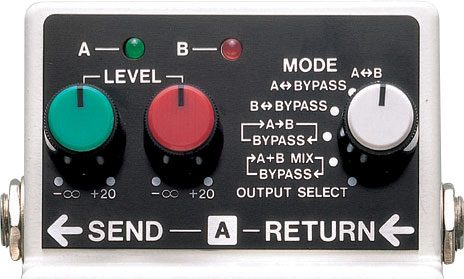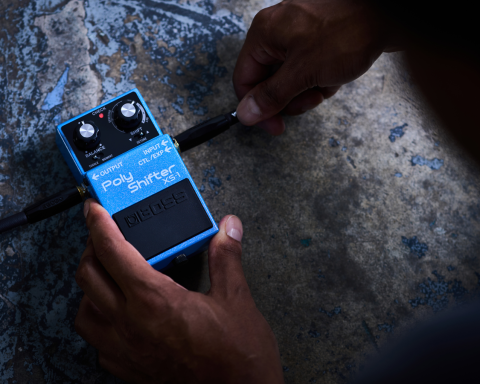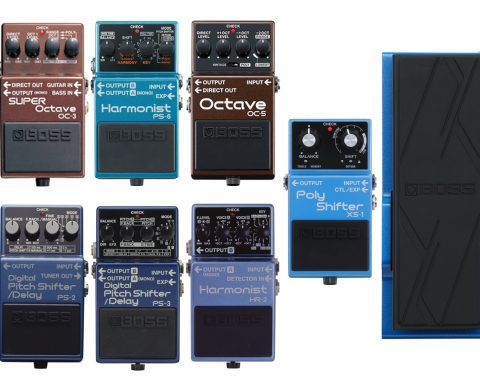A line selector is a utility pedal with many applications. Some uses are obvious, others outlandish. All are extremely useful and can help create new ways to use other effects, amplifiers, and instruments. The BOSS LS-2 has been an industry standard in this capacity, unchanged in design since 1991. It has a surprising versatility for a pedal whose only function is to cycle through routing options. As with many effects pedals in production for decades, guitarists have found new functions for line selectors. Learn to maximize this handy device.
What is a Line Selector?
A line selector is a pedal designed to switch between other effects, amplifiers, or route input and output signals. Its vast capabilities can work for simple switching or complex parallel effects shaping. It’s a valuable control-expanding tool for any guitar setup.
FIVE LINE SELECTOR PEDAL USES
1. Effects Mixing in Parallel
One of the most popular and creative ways to use a line selector is to blend two effects in parallel to create new, exciting sounds. By mixing the effects in parallel rather than in series, neither effect gets altered by the other. Instead, they both work independently. This approach can be beneficial for creating rich, dynamic, three-dimensional sounds.
One can use this function to create huge overdrive tones. For example, suppose a guitarist likes the cutting, treble-heavy attack of a two-transistor fuzz pedal but finds it lacks sufficient low end. The LS-2 could run a second overdrive with a bass-rich character alongside the other pedal. The player could then blend the EQ sections of the two pedals to create a massive, full-bodied tone.
"One of the most popular and creative ways to use a line selector is to blend two effects in parallel to create new, exciting sounds."
2. Multiple Effects Switching
A line selector can reduce the amount of pedalboard tap dancing that comes with using many effects. Perhaps a player’s overdrive tone is an octave pedal and distortion, and their clean tone is a chorus and delay. An LS-2 can switch between the two sets of effects with a single footswitch stomp. This setup reduces the frantic tap dance to switch four pedals to one stomp.
With the LS-2, we can achieve this in several different ways. Still, the simplest is to select the A or B setting and to connect the octave pedal and distortion to the send and loop A return. The chorus and delay should go to the send and return of loop B. The LS-2 footswitch can then toggle between the effects of loop A and loop B, bypassing two of the effects and engaging the other two with each stomp.

3. Output Selector
Double amp setups are a great way to maximize the impact of a heavy section or shape an amp tone by sculpting it from the best bits of two unique amplifiers. A line selector isn’t just for effects pedals and can easily switch between and blend multiple amplifiers. If all one needs to do is switch between amplifiers, then a simple way to do that using the LS-2 is to use the A or Bypass function. Connect amp one to the normal pedal output and amp two to loop A’s send output. The LS-2 can toggle between each amp. This use is perfect for guitarists with one clean and one dirty amplifier.
More often than not, however, a multi-amp setup needs to be able to blend both amplifiers. An interesting way to do this might be to run a guitar into the input of the LS-2 and send the output to amp one. Then, as before, use the Send for loop A as an output to amp two. Using the A+B mix or bypass function of the LS-2, the pedal’s footswitch will toggle between the standard output, running to amp one and blending the two amplifiers.
This use is ideal for maintaining the clarity of the clean amp and the colossal tone of the driven amp without a jarring switch. It’s also great if amp two’s purpose is to lift a section of a song rather than offering an alternative tone.
“A line selector isn’t just for effects pedals and can easily switch between and blend multiple amplifiers.”
4. Input Selector
We can apply the same method to instruments as well. Doing so allows the player to switch between two guitars during a set without changing cables constantly. This use is perfect for guitarists who use multiple tunings in a live setting or want a backup.
Achieving this with the LS-2 requires some clever thinking. Position the LS-2 before any other pedals. Then, connect the first guitar to the return input of loop A and the second guitar to the return input of loop B. Finally, connect a dummy patch cable to the pedal’s master input. This keeps the pedal on; the pedal will remain bypassed without a jack input. Now, with the LS-2 set to A or B mode, it’s possible to toggle between the two guitars leaving the other bypassed.
5. Clean Blend for Bassists
Another clever solution a line selector can provide is adding a clean blend to any existing effects pedal in a rig. Guitarists and bass players alike can use this. But it is convenient for bassists, who often find their overdrive options limited by the need for full-range drive pedals. The LS-2 is one of very few pedals with a clean blend built in to maintain the clarity and punch of the low end.
An LS-2 can create a simple, clean blend alongside the overdriven signal. Connect the overdrive pedal to the send and return of loop A, and connect a dummy patch cable to the send and return of loop B. This use might seem odd, but the patch cable creates a clean loop alongside the overdrive effect.
By selecting the A+B or bypass mode on the LS-2, the master level control from loop B can blend in a clean signal parallel to the overdrive. The footswitch switches between the blended drive and a bypassed clean tone.
"The LS-2 is one of very few pedals with a clean blend built in to maintain the clarity and punch of the low end."
Augment a Setup
A line selector can be a fantastic creative tool. The only limitation is one’s imagination. Enjoy new effect combinations, multi-amp setups, easy instrument swaps, and more. Using a line selector is a straightforward but effective way to augment any guitar setup.






